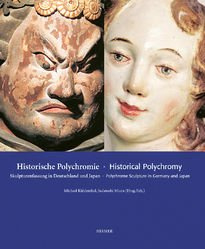Historische Polychromie – Historical Polychromy
- The polychromy of a work of art is for its understanding just as important as its formal design.
The polychromy of a work of art is for its understanding just as important as its formal design. When a sculptor has finished carving a wooden sculpture, it is brought to life by the polychromy of the painter, which is crucial for its expression and effect.
However, today most sculptures look different than at the time of their making. The few original polychrome surfaces that are still visible have changed with aging, whereas most sculptures have been overpainted, often several times, in order to adapt them to the taste of later periods. Thus following a research program on lacquers developed by the Bavarian State Department for Historical Monuments and the National Research Institute for Cultural Properties in Tokyo, a German-Japanese research project has been dedicated to the investigation of the original colouring of sculptures in order to embrace the current questions existing in both countries.
The conservator will find numerous investigations in this richly illustrated volume, which are documentated by comprehensive descriptions of cross sections and diagrams. Art historians, curators of monuments and interested readers will find information, which can lead to a deeper understanding of the past periods and a more critical observation of sculptures regarding their surfaces. A bibliography of the most important literature and a glossary of Japanese technical terms are included in this work.
blklk

